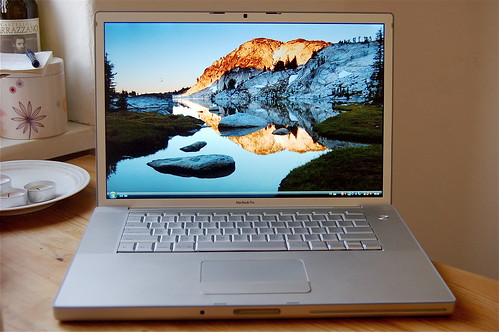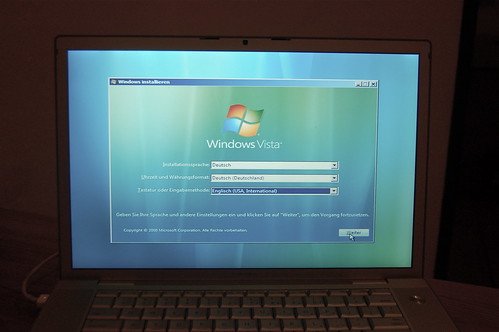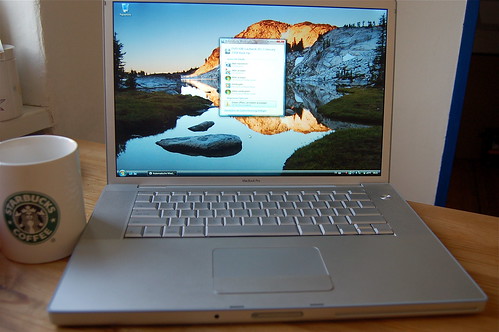Yesterday, I partitioned my MacBook Pro’s hard drive and installed Windows Vista via Boot Camp. The installation process itself was actually very easy; it was only the preparation that was time consuming.
After I decided to add Windows to my Mac, the first step was decide upon a version. I ruled out XP quickly for two reasons, both of which may yet prove unwise. First of all, I love new things, maybe I’m even a sucker for them. Vista isn’t new anymore, but it feels far newer to me than XP, which I’ve been using touch-and-go on other computers for years. Second, I’ve been told that Vista is running a newer version of Uniscribe; also, Vista does come bundled with a lot of new fonts, as well as improvements to some old ones. Later in the year, I’ll be needing Windows because of VOLT, but for now I’ll be using it to typeset with OpenType Devanagari fonts—you can’t do that on MacOS X, which is actually quite mind-boggling for someone who drinks as much Apple Kool-Aid as I do. In this case, I figure, a newer Uniscribe might not be too shabby. I guess that I’ll be able to verify this is a few days…to ease my Mac to Windows transition, I’ve got a borrowed PC laptop running XP alongside of me.
But even after deciding for Vista, there are still a boatload of versions to select from. I ended up selecting the 32-bit Home Premium Edition. Why? Well, Boot Camp tells you that you need a 32-bit version, not a 64-bit. Also, I don’t feel the need to pay more for the license to a Business or Ultimate version. And Home Premium instead of Home Basic? Well, the difference was just about €5—here’s to ponying up more cash for flashy graphics!
Since I’m in Germany at the moment, I purchased a German-language version. This means that the Mac half (err… two-thirds!) of my computer speaks to me in English, while the Windows part does so in German. This isn’t a problem for me, since I seem to speak English with about two-thirds fluency, and maybe German with a little better than 1/3 ;-) I must admit that I wish I could choose my own language the way that I could with Mac OS X, though.
I placed my order over Amazon.de because they offered nicely low prices compared to brick and mortar computer stores; I also licensed Microsoft Office 2007 at the same time. The discs were delivered quite quickly.
To install Windows on a Mac, or at least on MacOS X 10.5 (Leopard), the first thing you do is open up the Boot Camp Assistant in your Utilities folder. This has a 27-page instruction booklet that you need to print out, at least if you are angst-ridden about installing Windows on a Mac, like I was. Step two is to partition your hard drive. This gives you a new, clean section of your hard drive to run Windows from. I’ve been told this will protect the Mac portion of your hard drive from all those nasty Windows viruses.
I gave my new partition 20 GB. Vista itself needs half of that, and Office another 1.5 GB.
After partitioning is complete, you load the Windows installation disc and your computer restarts. Suddenly everything is all black and white, and you worry about having DOS flashbacks. Then everything goes color, and the installation process begins. The installer—and Windows—do not at first know how to deal with Apple’s monitors, and this is not their fault. It just means that for the next few steps, you have to look at everything through a horizontally-stretched lens. That’s right… artificially-widdend Segoe. And lot’s of it. Have antacid tablets on hand if things like this bother you.
Once Windows is installed on your partition, and the computer has restarted twice, you have to find the command on Windows that will eject your installation disc for you. You see, you haven’t installed the Boot Camp drivers from Apple that tell Windows how to talk to your computer yet, so the eject button on the Mac keyboard won’t work! Fortunately, the 27-page instruction guide is there to lend a hand and tell you where to look. After this disc is ejected, you’ll need to insert your Mac OS X 10.5 (Leopard) installation DVD. This has those necessary Boot Camp drivers on it, which include:
- graphics
- networking
- audio
- AirPort wireless connectivity
- Bluetooth®
- iSight camera
- Apple keyboards
- Apple Remote
- brightness control for built-in displays
After another restart, everything looks beautiful, and actually, I quite mean that. The desktop resizes properly, the type looks great, and you’re good to go. Well, you’ll need to go online and authenticate your software, but other than that, I haven’t run into much yet. To my surprise, another restart wasn’t required after I went on to my own next step and installed Office 2007.
The only problem so far is time: the Mac part and the Vista part of my computer cannot agree on the time, and already, this makes me annoyed. I have them both set to the same time zone, yet when I restart in Mac OS, my Mac all of a sudden thinks that it is an hour later. When I change the time back one hour, and then restart in Vista, the clock changes here as well, but the two clocks are still off by an hour!



